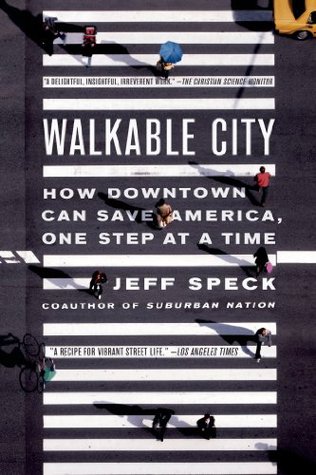More on this book
Community
Kindle Notes & Highlights
by
Jeff Speck
Read between
May 1 - May 4, 2016
These numbers become especially meaningful as we consider the impacts of peak oil prices in the years ahead. What city, or country, is likely to be the most competitive in the face of $200-per-barrel oil?
Imagine two brothers eating lunch alongside a dock in Dublin, Palermo, Bombay, or Formosa and looking wistfully out to sea. One of them had the balls to get on a boat and the other one didn’t. Guess whose kids are the Americans?
So the traffic study has become the default act of planning, and more than a few large companies can thank traffic studies for the lion’s share of their income. They don’t want you to read the next few paragraphs. Traffic studies are bullshit. They are bullshit for three main reasons:
First: The computer model is only as good as its inputs, and there’s nothing easier than tweaking the inputs to get the outcome you want. When we were working in Oklahoma City, the local traffic engineer’s “Synchro” computer model said that our pro-pedestrian proposals would cause gridlock. So we borrowed that engineer’s computer model and handed it to our engineer, who tweaked the inputs, and voila: smooth sailing. By the way, the most commonly tweaked input is anticipated background growth, which typically needs tweaking anyway: most cities’ traffic models presume 1 to 2 percent annual
...more
Amit Bhojane and 1 other person liked this
Second: Traffic studies are typically performed by firms that do traffic engineering. This makes perfect sense—who else would do them? But guess who gets the big contract for the roadway expansion that the study deems necessary? As long as engineers are in c...
This highlight has been truncated due to consecutive passage length restrictions.
Finally, and most essentially: The main problem with traffic studies is that they almost never consider the phenomenon of induced demand. Induced demand is the name for what happens when increasing the supply of roadways lowers the time cost of driving, causin...
This highlight has been truncated due to consecutive passage length restrictions.
Amit Bhojane liked this
This ad is, to put it mildly, misleading. It is misleading on so many levels it is hard to know where to start pulling it apart. At the very least, it is misleading in what it says, what it implies, and what it assumes. It says that new roads can reduce congestion, when we know that new roads almost always increase congestion. It implies that the dramatic surge in vehicle miles traveled since 1980 was not explicitly caused by infrastructure improvements, when we know that it was. Finally, it assumes that congestion wastes fuel, when we know that congestion actually saves fuel—and ultimately is
...more
Adam liked this
It would seem that only one thing is more destructive to the health of our downtowns than welcoming cars unconditionally and that is getting rid of them entirely. The proper response to obesity is not to stop eating, and most stores need car traffic to survive. With autos reintroduced, most failed pedestrian malls, like Monroe Place in Grand Rapids, have come back at least partway. The key is to welcome cars in the proper number and at the proper speed.
Adam liked this
Well, as a New Yorker would say, “Screw you, too.”
The smart cities, like Lowell, hire a director of planning and development, who is first charged with creating a city where people want to be. Rather than trying to land new office tenants in a shrinking office market, this person understands that future economic growth will take place where the creative people are, and then works to lure more residents downtown.
Adam liked this
how do you create a transit-and-walking culture in a place where driving is so easy? It may not be possible. In some of these locations, the bus is destined to remain the “loser cruiser,” the mode of choice for those who have no choice: the elderly, poor, and infirm. As such, it will always be underfunded and struggling for survival, like any social service.
The byword here is to provide service frequently or not at all. Limiting service due to limited ridership is a death spiral that few transit lines survive.
many cities across the country are finding it politically possible to introduce something called a “road diet.” In a road diet, a standard four-lane street is replaced by a three-lane street: one lane in each direction and a center lane reserved for left turns. What is remarkable about road diets is not that they save lives—that is to be expected. In a typical road-diet conversion, Orlando’s Edgewater Drive, the number of crashes fell by 34 percent and, because the crashes were slower, the number of injuries fell by an impressive 68 percent: from one per nine days to one per month. Rather, the
...more
Adam liked this
When we built our house, I put a sitting-height wall on both sides, and a prominent sidewalk-hugging bench by the front door. You would be surprised how often someone sits there. Never mind that on occasion that person is a homeless crack-smoking schizophrenic … it was the right thing to do.
Adam liked this


